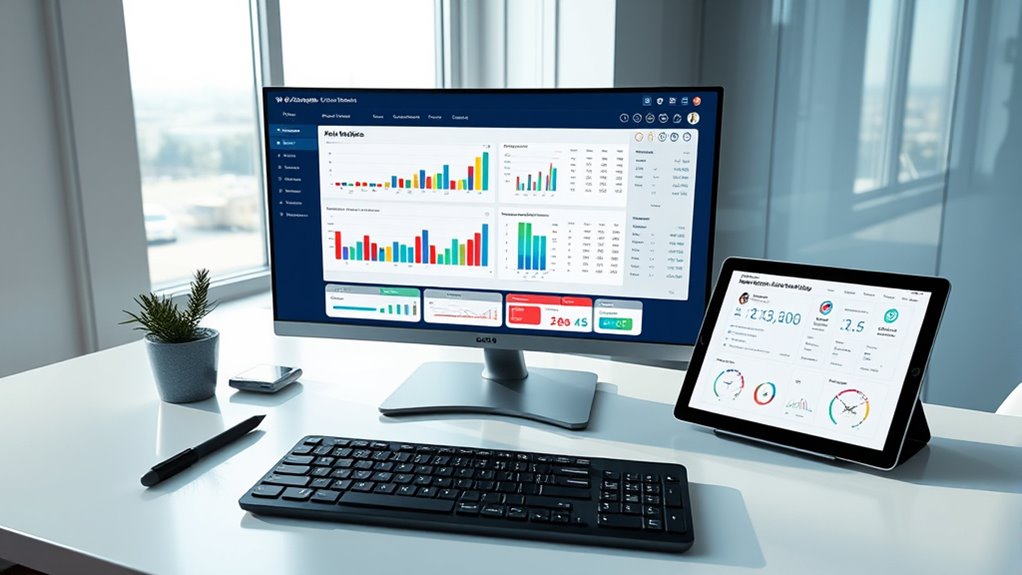A KPI tracking sheet for shift managers helps you monitor essential metrics like task completion, attendance, and customer feedback in real time. By customizing your metrics to fit your team’s goals, you can quickly identify issues and celebrate successes. Use a well-designed template with instant data entry to improve accountability and foster continuous improvement. Staying consistent and updating your sheet regularly will optimize shift management—further insights await if you keep exploring this topic.
Key Takeaways
- Design a clear, organized spreadsheet with columns for KPIs, targets, actual results, and dates for easy monitoring.
- Select relevant KPIs like task completion, handle time, and error rates aligned with shift goals.
- Use color coding and visual cues to quickly identify performance status and areas needing improvement.
- Regularly review and analyze KPI data to track trends, adjust targets, and inform decision-making.
- Ensure data security with regular backups and controlled access to maintain integrity and confidentiality.
Identifying Key Performance Indicators for Shift Management

When managing a shift, pinpointing the right Key Performance Indicators (KPIs) is essential for measuring success and identifying areas for improvement. Start by focusing on metrics that directly impact your team’s productivity and customer satisfaction. Common KPIs include task completion rates, average handle time, and error rates. You should also track attendance, punctuality, and safety incidents to ensure a smooth operation. Consider customer feedback scores to gauge service quality. It’s important to choose KPIs that align with your goals and are easy to measure consistently. Avoid overwhelming yourself with too many metrics; instead, select a core set that provides clear insights. Regularly reviewing these indicators will help you spot trends and make data-driven decisions to optimize shift performance. Additionally, monitoring essential oils for specific health concerns can provide insights into employee wellness and overall team health.
Designing an Effective KPI Tracking Template
Creating an effective KPI tracking template is essential for monitoring shift performance efficiently. To start, organize your template with clear columns for each KPI, target benchmarks, actual results, and date stamps. Use simple, consistent formatting so you can quickly interpret data at a glance. Incorporate color coding—green for on track, yellow for caution, and red for underperformance—to make issues stand out immediately. Include space for notes or comments to capture context or action plans. Keep the layout flexible enough to accommodate new metrics as your team’s goals evolve. Remember, a well-designed template should streamline your review process, reduce confusion, and help you identify performance trends swiftly. Focusing on data visualization techniques can further enhance the clarity of your reports. Focus on clarity and usability to ensure your tracking sheet serves as an effective management tool.
Customizing Metrics to Fit Your Team’s Goals

After setting up a solid KPI tracking template, the next step is to tailor your metrics to align with your team’s specific goals. This ensures your KPIs are meaningful and drive the right actions. Start by identifying what outcomes matter most—whether it’s improving customer satisfaction, reducing wait times, or boosting sales. Then, select metrics that directly reflect these priorities. For example, if your focus is on efficiency, track average handling time; if it’s quality, monitor error rates. Remember to customize the targets for each metric based on your team’s current performance and growth plans. Focusing on best arcade machines for home game rooms (2024) can inspire your approach to creating engaging, fun environments for your team.
Implementing Real-Time Data Entry and Monitoring

Implementing real-time data entry and monitoring allows you to capture performance metrics instantly, providing immediate insights into your team’s activities. This approach helps you identify issues quickly, make swift adjustments, and keep everyone aligned with goals. It also fosters accountability, as team members see their progress live. To motivate your team, consider this emotional impact: hydrocolloid technology promotes healing by drawing out impurities and creating a protective barrier against bacteria and dirt. | Feelings You Can Inspire | Benefits You’ll See | Outcomes You’ll Achieve |
| ————————– | ——————— | ———————— |
|---|---|---|
| Confidence in your leadership | Faster decision-making | Improved team performance |
| Pride in daily progress | Reduced errors | Higher KPI achievement |
| Trust in your processes | Increased engagement | Sustained growth |
Analyzing Performance Data for Continuous Improvement

Analyzing performance data is essential for identifying trends, pinpointing areas for improvement, and making informed decisions that drive continuous growth. By regularly reviewing your KPI data, you can spot patterns that reveal strengths and weaknesses. This helps you focus your efforts where they matter most. To enhance your analysis, consider these key actions:
- Compare current data with historical benchmarks
- Identify fluctuations and seasonal variations
- Highlight underperforming metrics for targeted action
- Recognize high-performing areas to replicate success
- Incorporate effective cleaning tools to better understand their impact on overall performance
This process enables you to adapt strategies proactively, optimize resource allocation, and motivate your team with data-backed insights. Consistent analysis keeps you aligned with your goals and fosters a culture of continuous improvement, ultimately boosting overall performance.
Sharing Insights and Collaborating With Your Team

Sharing insights with your team is essential for fostering transparency and collective responsibility. When you openly discuss KPI data, your team understands performance expectations and identifies areas for improvement. Encourage honest conversations by presenting data clearly and objectively. Ask for input and insights from team members to uncover underlying issues or innovative solutions. Collaborate to set actionable goals based on the data, which boosts motivation and accountability. Regularly sharing progress keeps everyone engaged and focused on common objectives. Remember, transparency builds trust, so celebrate successes together and address challenges constructively. By fostering an environment of shared knowledge, you empower your team to take ownership of their performance and drive continuous improvement. Additionally, understanding the horsepower of electric dirt bikes can help set realistic performance goals and expectations. This collaborative approach enhances team cohesion and overall operational efficiency.
Automating Data Collection and Reporting Processes

Automating data collection and reporting processes streamlines how shift managers monitor KPIs, reducing manual effort and minimizing errors. By integrating tools like spreadsheets with automated data feeds or specialized software, you can guarantee real-time updates and consistent accuracy. This saves you time and allows you to focus on analysis and decision-making rather than data entry. Incorporating practices like mindfulness can further enhance focus and reduce stress during data review, leading to more attentive oversight. Consider these benefits: – Automated data pulls from point-of-sale or inventory systems – Real-time KPI dashboards for instant insights – Scheduled reports that generate automatically – Alerts for KPI thresholds or anomalies Implementing automation helps keep your KPI sheet current and reliable, eliminating the risk of human error. It also enables quicker responses to performance issues, ensuring your team stays on track.
Tips for Maintaining and Updating Your KPI Sheet

To keep your KPI sheet accurate and useful, regular maintenance and updates are essential. Schedule weekly reviews to verify data accuracy and identify inconsistencies early. Always update KPIs promptly when shifts or procedures change to reflect current performance. Use automation where possible to reduce manual errors and save time. Keep your data organized by clearly labeling categories and maintaining consistent formats. Encourage team members to report discrepancies or suggest improvements, fostering engagement. Set reminders to review and analyze KPIs regularly, and adjust targets as needed based on performance trends. Regularly backing up your data prevents loss and ensures continuity. Additionally, understanding relevant anime movies can boost team morale through shared interests, enhancing communication and teamwork. By staying proactive with updates, you’ll ensure your KPI sheet remains a reliable tool for managing shift performance effectively.
Frequently Asked Questions
How Often Should KPI Data Be Reviewed for Optimal Results?
You should review KPI data regularly to guarantee ideal results. Weekly reviews allow you to spot trends, address issues promptly, and adjust strategies as needed. If your operations are more dynamic, consider daily checks for critical metrics. Consistent review helps you stay proactive, improve team performance, and meet targets efficiently. Ultimately, the frequency depends on your business needs, but staying consistent is key to leveraging KPI insights effectively.
What Tools or Software Integrate Best With KPI Tracking Sheets?
You want to know what tools work best with KPI tracking sheets. You should look for software that integrates seamlessly, like Excel, Google Sheets, or specialized platforms like Tableau or Power BI. These tools allow you to visualize data easily and automate updates. You can also connect them with your existing systems, such as CRM or ERP, to streamline data collection and improve real-time tracking.
How Do I Handle Inconsistent Data Entries Across Shifts?
Did you know that inconsistent data can reduce reporting accuracy by up to 30%? To handle this, you should establish clear data entry standards and conduct regular audits. Train your team on proper entry procedures, and use validation rules within your software to catch errors early. Automate data collection where possible to minimize manual input, ensuring shifts record consistent, reliable information, ultimately improving your overall data quality.
What Training Is Recommended for Shift Managers on KPI Utilization?
You should provide shift managers with extensive training on how to interpret and utilize KPIs effectively. This includes explaining what each metric measures, setting clear expectations, and teaching how to analyze data trends. Incorporate hands-on sessions using real data, and encourage questions to clarify misunderstandings. Regular refreshers will reinforce learning, ensuring managers stay confident in using KPIs to improve shift performance and make informed decisions.
How Can KPI Tracking Improve Team Motivation and Morale?
Imagine boosting your team’s motivation so much that productivity skyrockets into the stratosphere! Tracking KPIs keeps everyone laser-focused and aware of their impact, making them feel like superheroes saving the day. When team members see their progress clearly, morale surges because they feel valued and accomplished. You create a positive cycle where achievement fuels enthusiasm, transforming your team into unstoppable forces of success, all driven by simple, effective KPI tracking.
Conclusion
By implementing an effective KPI tracking sheet, you’re empowering yourself to monitor and improve shift performance continuously. Customizing metrics and leveraging automation can save you time and boost accuracy. Remember, are you truly maximizing your team’s potential if you don’t regularly review and update your KPIs? Stay proactive, stay engaged, and keep refining your approach to guarantee ongoing success and growth for your team.









